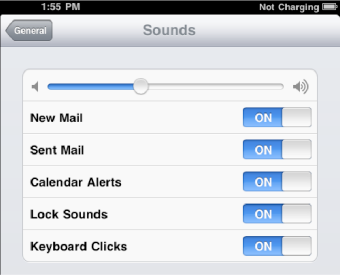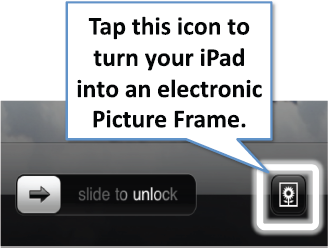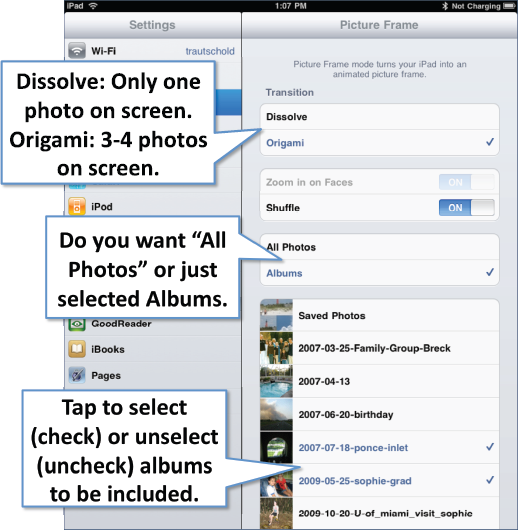1. Adjusting Sounds on your iPad
You can fine-tune your iPad so
that it does or does not make sounds when you receive new mail, send
mail, the caledar alarm rings, the keyboard clicks or the when it is
locked. To adjust sounds, follow these steps:
Tap General in the left column.
Tap Sounds in the right column.
Tap any of the switches to turn On or Off the sound when the event occurs.

|
On a related note to sounds,
you can lock the maximum volume playable from the iPod app. Go into
Settings > iPod > Volume Limit > Lock Volume Limit.
|
2. Personalize Your Picture Frame
Picture Frame is the app that lets you display a slideshow of photos on your locked iPad (see Figure 1). We'll describe the many ways you can customize the display.
2.1. Starting or Stopping the Picture Frame App
You may have noticed the little icon next to the slide to unlock slider bar when your iPad is locked. This is the Picture Frame icon.
Tap this icon to turn on the electronic picture frame.
Tap the icon again to turn it off.
Picture Frame will cycle through all your pictures, or you can customize it to show only selected photo albums.

|
If you have private pictures stored on your iPad, it could get quite embarrassing if Picture Frame
accidentally displays these photos while in locked mode. This section
shows you how to restrict the albums that are used for the slideshow.
|
|
NOTE
You can disable Picture Frame by setting a passcode security lock on your iPad.

2.2. Customizing Your Picture Frame
Depending on the types of pictures you have stored on your iPad, you will almost certainly want to set up your Picture Frame to display just the albums or photos you want. To do this:
Tap Picture Frame in the left column.
Now, you can adjust various settings for the picture frame: (Figure 2).
If you want to show only one picture on the screen at a time, select Dissolve. If you want three to four images at once, select Origami. Origami will show 2–4 images on the screen and them have them fold over on eachother sort of like you are folding paper.
Zoom in on Faces is selectable only if you've chosen the Dissolve transition. This is a neat feature that will zoom in on any faces detected in the individual photos,
Set Shuffle to ON if you want Picture Frame to randomly go through the selected photos.
If you want all your photos to be included in the slideshow (the default setting), select All Photos.
People often want to keep some photos private. To do so, select Albums, then tap or check the albums to include. (The check indicates that an album will be included.)

|
To really control what Picture
Frame displays, set up an album on your computer with only the images
you are happy to have everyone see when the device is locked. Then sync
that album to your iPad using iTunes.
|
3. Keyboard Options
You can fine-tune your keyboard by selecting various languages and changing settings like Auto-Correction and Auto-Capitalization.